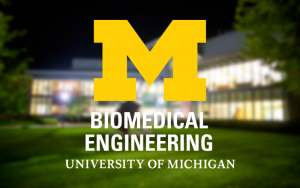Presented By: Biomedical Engineering
Traditional and Non-Traditional Inputs to the Vestibular System
BME PhD Defense: Stephanie Haggerty

One of the primary functions of the vestibular system is to provide stabilizing reflexes to the eye, head, and body. These reflexes are often coordinated with inputs from the visual and proprioceptive systems. More recently, research has shown that other, non-traditional, stimuli also effect the vestibular system, though the scope of this research has been limited. This thesis explores the effect of both traditional and non-traditional inputs on the vestibular system by characterizing their influence compensatory eye, head, and body movements.
We begin by looking at the influence of the vestibular periphery and efference copy of motor commands on compensatory eye movements (Chapter 2). While each of these has been described individually (as the vestibular-ocular reflex (VOR) and pre-programmed eye movements (PPEM) respectively), there has been controversy in the field as to how these two inputs interact with each other. We propose a model of gaze stability in which VOR and PPEM work cooperatively, and we test model predictions against data we collected as well as from previous findings. We found that our model accurately predicted eye movements during a variety of behavioral contexts. In Chapter 3, we describe the effect of single high-intensity noise exposure on the vestibular system by evaluating eye and head stability. We found that after noise exposure ocular stability showed marginal loss, while head stability showed greater deficits. However, the exact nature of this deficit was not as expected and the influence of cervical pathways after vestibular lesion is discussed. Finally, in Chapter 4, we examine the effect of galvanic vestibular stimulation and optokinetic stimulation on standing posture. We propose a model of postural stability inspired by the velocity storage model of ocular stability and test model predictions against body movements elicited from standing subjects. We found that, while simple, our model could correctly predict the nature of subjects’ responses to both stimuli, suggesting that the body interprets and uses sensory information for postural stability in a manner similar to that for ocular stability.
Taken together these findings demonstrate that the influence of non-traditional inputs and pathways to vestibular system is substantial and should be considered both in laboratory and clinical settings. We also show that the vestibular system allows researchers and clinicians to leverage methods and findings from across disciplines and species. Models traditionally used to describe gaze stability in primates can be used to predict eye movements in rodents as well as postural responses in humans and paradigms used in hearing research can be used to interpret noise-induced vestibular loss. Thus, the multifaceted nature of the vestibular system both requires, and allows for, multifaceted exploration.
Date: Tuesday, January 16, 2018
Time: 1:30 PM
Location: 2813/17 Med Sci II
Chair: Dr. William King
We begin by looking at the influence of the vestibular periphery and efference copy of motor commands on compensatory eye movements (Chapter 2). While each of these has been described individually (as the vestibular-ocular reflex (VOR) and pre-programmed eye movements (PPEM) respectively), there has been controversy in the field as to how these two inputs interact with each other. We propose a model of gaze stability in which VOR and PPEM work cooperatively, and we test model predictions against data we collected as well as from previous findings. We found that our model accurately predicted eye movements during a variety of behavioral contexts. In Chapter 3, we describe the effect of single high-intensity noise exposure on the vestibular system by evaluating eye and head stability. We found that after noise exposure ocular stability showed marginal loss, while head stability showed greater deficits. However, the exact nature of this deficit was not as expected and the influence of cervical pathways after vestibular lesion is discussed. Finally, in Chapter 4, we examine the effect of galvanic vestibular stimulation and optokinetic stimulation on standing posture. We propose a model of postural stability inspired by the velocity storage model of ocular stability and test model predictions against body movements elicited from standing subjects. We found that, while simple, our model could correctly predict the nature of subjects’ responses to both stimuli, suggesting that the body interprets and uses sensory information for postural stability in a manner similar to that for ocular stability.
Taken together these findings demonstrate that the influence of non-traditional inputs and pathways to vestibular system is substantial and should be considered both in laboratory and clinical settings. We also show that the vestibular system allows researchers and clinicians to leverage methods and findings from across disciplines and species. Models traditionally used to describe gaze stability in primates can be used to predict eye movements in rodents as well as postural responses in humans and paradigms used in hearing research can be used to interpret noise-induced vestibular loss. Thus, the multifaceted nature of the vestibular system both requires, and allows for, multifaceted exploration.
Date: Tuesday, January 16, 2018
Time: 1:30 PM
Location: 2813/17 Med Sci II
Chair: Dr. William King